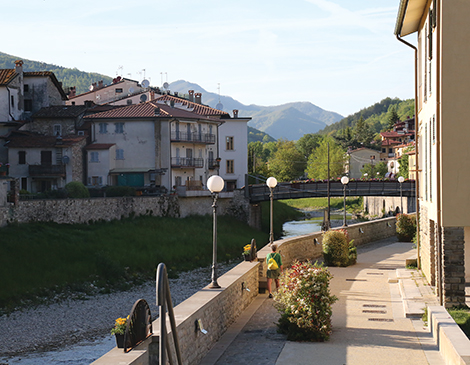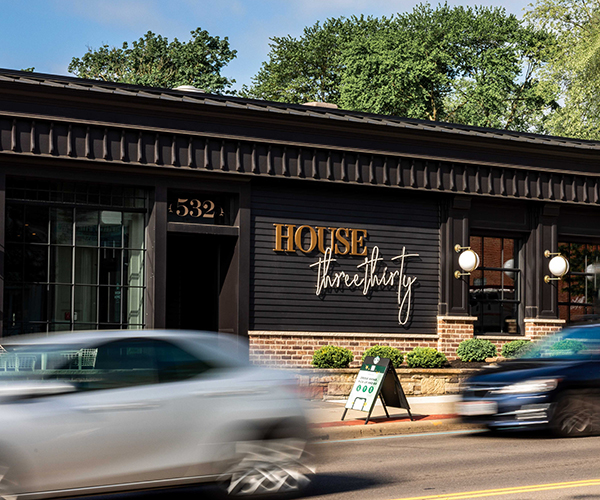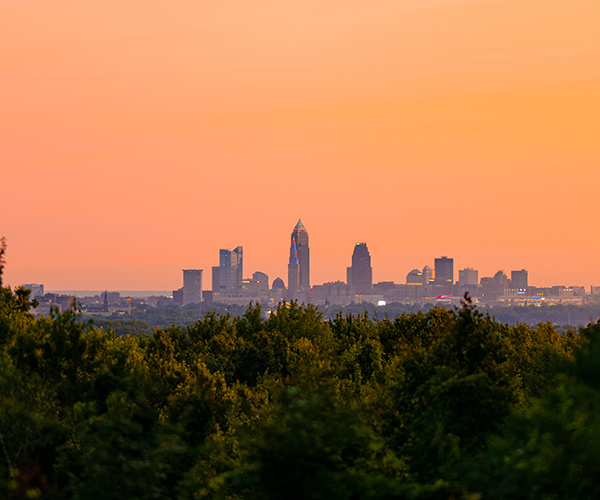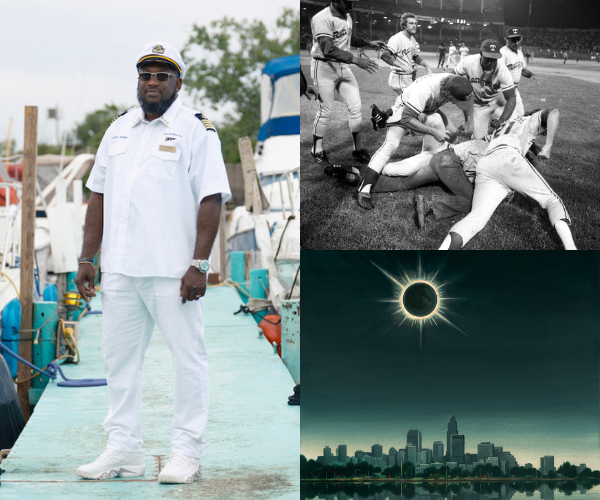Nine hours after 12 black-robed nuns give me the pilgrim’s prayer, I am dehydrated, lost and seething in the bucolic Tuscany wilderness.
I’m lost for two reasons: St. Francis and my grandmother, Angelina. St. Francis — the doughnut-haired, tunic-
wearing lover of animals — because I am a credentialed pellegrino (pilgrim) of his eponymous trail. The 312-mile route is a monthlong trip from the 12th-century convent of La Verna (52 miles southeast of Florence) to the Vespa-and-orange-tree metropolis of Rome. I’m on day one. I want to imitate Francis, so I hike with my phone dark, food sparse and St. Benedict crucifix dangling around my neck.
But I also blame my grandmother, a mystic in her own right, a cross between a crystal-owning reiki enthusiast and a Pope John Paul II-era Roman Catholic. For four decades, Nan dreamt of once again walking her madre patria. But aging is an exercise in deprivation. In 1996, Nan lost her second husband, Ralph, to lung cancer. In 2008, after a bout of congestive heart failure in Las Vegas, her ability to fly. In 2016, her North Royalton two-story townhouse. One year later, her immaculate Ford Taurus. In 2019, her short-term memory. Then, in 2020, us.
We all know collective loss now, a type of poverty, if you will. COVID-19 lockdowns made us creatures of less. Fewer friends. Fewer restaurants. Fewer churches, desks, parents and lovers.
This vacuum shifted our notion of the metaphysical. In 2020, Pew Research Center found that COVID-19, with its trailers of bodies and reddened maps, increased 28% of Americans’ belief in a higher power. A full 35% think “God taught us a lesson.” Two years of emptiness has, experts say, also increased booking of spiritual travel.
“This year has been off the charts,” says Caitlin Weich, marketing specialist at Follow the Camino. Although hikers on Spain’s Camino de Santiago, the world’s most popular pilgrimage, dropped 60% in 2020, 2022’s count is bound to surpass 2019’s 347,000. June was the company’s “biggest sales month ever.”
“A lot of people are just trying to process various emotions that have been intense and built up over the last two years.” These people, she says, “need to reconnect with themselves.”
Here is good a point to divulge that, for most of my life, I’ve been a wavering agnostic. At 14, a militaristic nun at Sts. Joseph and John School in Strongsville had to beg me to get confirmed. In college, I swore my soul to the Tao of Physics. It’s not that I didn’t believe in God; I just didn’t know what God was.
On April 30, I bought a one-way ticket on Neos Air for $401. After two years as the pandemic’s grim epicenter, Italy eased travel restrictions. I touched down in Milan on May 6. On May 11, after a tearful family reunion in Pistoia, I waved goodbye and set out for Assisi, the hometown of St. Francis and site of historic brotherhood.
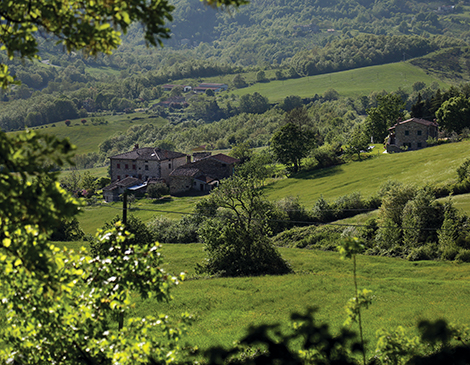
Nan disliked most, if not all, animals. Dogs were “annoying.” Cats were “useless.” "Menacing" deer defiled her beloved rose bushes. (She found swans “spiritual,” however.) At my brother Matt’s adopted Holland Lop rabbit, languorously named Hopper, Nan crimped her Italian lip. “You let it run around the house?” she asked. “Why?”
Ironically, Nan grew up on West 32nd Street and Clark Avenue surrounded by rabbits, cats, dogs and West Side Market chickens. They were reluctant friends — and sometimes food — for a monolingual Italian girl. This was immigrant heyday Cleveland, 1932. Nan’s dad, a stingy bricklayer with a big forehead named Ciro Pinozzi, had relocated his family to Cleveland after Mussolini’s Black Hand descended on their hometown of Calamecca. In 1936, Nan lost her 9-year-old twin sister, Bice, to pneumonia. At Bice’s repast, I imagine their mother, Valentina, making coniglio in umido, rabbit stew.
Nan’s life was like a deposit box, full of gems to those who were privy to its contents. To leave her father’s house, Nan told me, she married a Roman-nosed turret gunner who signed himself “Midge” in wartime V-mail. He’d give Nan five children but eventually abandon her. In 1969, despite the Vatican’s tough moral code, they divorced. “[The church] shunned her," my mother recalls. "It really bothered her because she went to Mass every Sunday.”
In the ’70s, Nan blossomed her universal principles. In 1973, she remarried, a homebody Cleveland Press print setter she met waiting tables at Perkins Restaurant in Kamm’s Corner. She studied numerology and astrology at Cuyahoga Community College. At the height of the American New Age craze, she began to explore Spiritualism. I’d later call her the Buddha of West 128th Street.
“To do what I can to instruct and teach others to live a purposeful life,” she wrote on June 17, 1994. “To trust and have faith in humanity and the universe.” By 1996, after burying her second husband, Nan had shifted fully into her Catholic Spiritualist synthesis. By the late ’90s, three or four people came to her a week for a reiki healing or a tarot card life dissection.
“This will be your year of transformation,” she’d tell you, eyelids shut, fingertips on palm. “Something big. A raise? Maybe a new job? Twenty-nine is the year of Jupiter return.”
A skeptical 28 year old, I’d offer a snide, “Oh, nice.”
“Mark, maybe we’ll make money,” Nan would nudge, an easy stab for a journalist. “Muh-ney.”
In 2018, at the age of 91 and after four carotid artery surgeries and early onset dementia, Nan reluctantly moved into Parma’s Vista Springs, a Disneyland of an assisted care center. An 18-inch statuette of Antonio Canova’s Three Graces and a family acrylic of hilltown Sorano comforted her but teased her lack of locomotion. Then came the pandemic.
“Mark, I’m here banging my head against the wall,” she told me over the phone in late 2020 as 6,000 a week were dying in nursing homes. “Is it crazy that I want to shoot myself?”
On March 2, I pay an in-person visit to Nan's apartment at Vista. She is on oxygen and strawing Ensure for lunch. She’s nearly immobile.
“Mark!” she calls from her bed by the window. Only her head is exposed from the comforter. “You had such big, blue eyes. You had such blond hair.” She bends to a Styrofoam cup. Her oxygen machine beeps on rhythm.
“I know,” I joke. I pick at my bangs in jest. “What happened to it?”
“I’m sorry I’m such bad company,” Nan says. “I’m not able to entertain you.”
Her mind cycles. 18th-century British maxims. My brother's famed temper tantrum circa 1997. Her first English word. Italy. The conversation jumps there.
“When,” Nan asks, “are you going back to Italy?”
A week later, at 5:32 in the afternoon, while holding my Aunt Alicia’s small hands, Nan tilts her head towards the Parma sky, and dies.

“Lord, make me humble,” Francis’ brotherhood used to pray, “even at the price of losing my two eyes.”
A tad masochistic, the prayer summarizes Francis’ ultimate striving. At 25, after a life of “sin” in wine-drunk Assisi, he forwent worldly pleasures. Seeing the divinity of less, he burned his clothes, became a beggar and lost old friends. “I am in love with a woman,” he gloated to disciples in 1212. “Her name is Lady Poverty.”
For this reason, cliché as it sounds, I walk from La Verna to Pieve Santo Stefano carrying little more than four outfits, a few pears, a bottle of water, a camera, my grandmother’s pewter cross, a tiny copy of Omer Englebert’s St. Francis of Assisi and a prayer card. To be honest, my goal is not 100% clear. Regardless, I have just one week to hike, mostly due to limited funds, so making it to Assisi would be ideal. My only intention is to disappear into the Tau trail markers, as if Francis, in his charcoal tunic and Ben Hur flip flops, had breadcrumbed the pathway himself. It’s what, I believe, Nan would want.
Cutting through olive fields, drunk on the air of Aleppo pine, I think:
Poverty, less. Less, good. Good, God.
Summiting a steep 4,200 footer in 82 degree sun, I also think: You’re grossly out of shape.
A nun said Pieve was a brisk four-hour stroll, but six hours in I reached the tiny village of Lama. This is wealthy Tuscany, stucco villas with arsenic green shutters, agriturismo bed and breakfasts, 21st century garages with Subarus parked neatly inside. “Dove vai?” one of the B&B owners, a bereted man with a face like a baseball mitt, asks me from his Fiat.
"Assisi," I say.
“Sei solo?”
“No,” I tell him, smiling. “Io sono con Dio.” With God.
“Beh,” he scolds and drives off.
The joke’s on me. Four hours later, around 7:15 p.m., I arrive at another hilltop ascent. By now, the Tuscan beauty no longer moves me. I’ve been out of water and food for hours, chewing Italian gum to drink saliva. My legs are robotic slaves to the tick-tock of sundown. Pieve is obviously not this way. You are a lost failure. You’re not worthy of your Eat, Pray, Love epiphany. I give up, turn my phone on and call my brother Matt. Francis must permit me 3G in a time like this.
“Wait, you’re where?” says Matt. He's poolside, sipping White Claws with the boys 4,700 miles away in uptown Dallas. His assessment overtakes my sudden survival anxiety. “Calm down, chief. Send me your coordinates. You’re not going to die.”
“I have really bad cotton mouth,” I say, “I’m, like, 10 minutes away from collapsing. I can’t walk any fur…”
“Coordinates!”
I text Matt my location — 43º38’33”N, 12º1’34”E — and he informs me I’ve overshot Pieve Santo Stefano by about 80 minutes. I’m essentially on an “express” trail that cuts through the Riserva Statale, a Tuscan Metropark. My legs guide me, as Matt directs to a connecting gravel trail a mile back north. It’s not the muscle give-out, I realize, that’s murdering me. It’s the fact that there was no certainty.
“What do you know about wild boar?” I ask Matt. Forty yards away a mother and her five boarlets climb across a ravine. As I approach, the mother stops and pivots. She leaps down to the trail, and snorts at me like the agitated swine in Lost. My body ricochets back like a jackhammer.
“You’ve got to be kidding me,” Matt says, again cueing up Google. “Hold on.”
I recall the tale of St. Francis and the wolf. A wolf was terrorizing the town of Gubbio. Gubbians were terrified to leave their homes, so Francis meets with the animal. During their confrontation, the wolf growls in a defensive flex. But Francis, like a saintly Bear Grylls, shows zero trepidation. Like Matt, he’s calm. “Come here, brother wolf!” Francis shouts. “In Christ’s name, I forbid you to be wicked!”
He brokers a deal: Gubbio feeds the wolf, the wolf ends its reign of terror. It goes back to, I presume, tricking German teenagers in rouge bonnets.
“Is it gone?” Matt says, legitimately concerned. “Is the boar still there?”
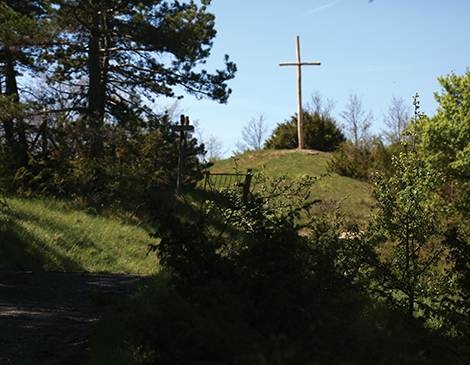
I’m in the car with Gianluca and Otto for two minutes, and they already want to take me to dinner.
You could say I prostrated myself. After reaching the truckstop town of Formole, dodging the boar attack by sprinting past the family, I came across an idling blue Dodge occupied by two 20-year-old Pieve residents. I bow to them, begging for a ride. They respect my blind 23-mile jaunt. “Ma andiamo a mangiare?” Gianluca says with a thousand-dollar smile, sensing my starvation. “No c’e problema.”
St. Francis was not St. Francis until he settled in Rivo Torto, a commune 58 miles south of Pieve
Santo Stefano. Rivo’s not just where the itinerant beggar capped off his First Order, but where he solidified the Six Franciscan Virtues — wisdom, simplicity, poverty, humility, charity, obedience. By singing, eating, sleeping and fishing at Torto, Francis realized: “Spiritual joy is as necessary to the soul as blood is to the body.”
I think about these virtues — namely humility — as Gianluca, Otto and I dine at the Hotel Santo Stefano, the finest eatery in Pieve. Like a bachelor party, we splurge on pints of Peroni, a flank of capicola, sheep’s cheese and pearl-shaped gnocchi al ragu that disintegrates on the tongue. “I don’t know how I can thank you,” I say in English, after we empty our pints. Taking the check, lucky to have sufficient euros, I introduce the guys as miei angeli to the server, Giulia.
My legs are inoperable, so I’m forced to remain in Pieve the following day. I text Gianluca. He insists I meet him and his Moroccan friends at the nearby Bar Europa for a “concert.” I show up at 8 p.m., freshened up. It’s all men, smoking Rothmans or drinking Montenegro, no “concert.” But they all know who I am: the American pellegrino. As in, the one who mindlessly walked 23 miles without data.
Amongst Gianluca’s friends is Michele Dini, a 20-year-old college student in Sansepolcro who occasionally moonlights as a deejay. Michele’s tall with a Luke Perry jawline and likes to impress with random Americanisms. “Once you at the top,” Michele says six times that night, “you don’t stop.” Michele’s friend Eugenio drives us to Lo Scorpione, a two-
story discotheque in Sansepolcro populated by university students. Eugenio speeds, hitting a vape, as Michele shares his dream of backpacking the Netherlands. We enter Scorpione with seven other guys in open-necked button-downs or designer T-shirts. "You like?” Michele asks me, as I hand my vax card to the bouncer.
Around 3 a.m., we form a loose circle on the dance floor as the deejay plays Jovanotti’s “L’ombelico del mondo.” Plumes of cigarette smoke mix with theatrical vapor. Yousseff tears off his shirt in ridiculous masculine pomp. Michele lights up a spliff in soft-eyed
ecstasy. Otto nearly spills his gin lemon. It might be a stretch, but as the seven of us jump dance shoulder to shoulder, I can’t help but feel this strange holiness, this ecstatic jolt from this seemingly mundane instance of fraternity. The effect is so profound that I start laughing on the dance floor. “Spiritual joy,” Francis said, “necessary to the soul.” Michele — reeking of sweat, smoke and cologne — wraps his arm around me. “Mark!” he yells in my ear. “Sei contento?”
We buried Nan on a Monday, in a discounted plot she bought with Ralph in 1994. First we eulogized her in the same church, St. Rocco’s on Fulton Road, where she was baptized 90 years before. As Matt and I trail the hearse with cousins from Seattle, I think about how fortunate we were to have a “normal” funeral. How the wake at Ripepi’s might’ve been just us 20, not the 273 that signed the guestbook. I put on “Un mazzo di fiori,” Nan’s go-to Italian operatic folk song. As if to stave off the near finality, Matt puts on the Eagles’ “Take It to the Limit” as the cemetery plot comes into view. “I can’t believe it,” Matt says, as the sun blinds us through the windshield.
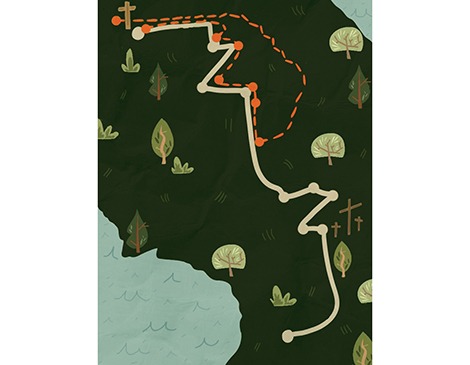
It’s 82 degrees the Monday I hike to Citerna, a small hilltown 12 miles south of Sansepolcro.
My wits are refreshed: I’ve packed two panini, two bottles of water, and downloaded a trail app for offline navigation. But it’s still hot, so after a three-hour jaunt, I find myself resting on the steps of the Comunitá Magnificat, a small church in the town of Fighille.
Across from me is a white-tent picnic, decorated with baroque Mother Marys and bottles of Coke. Maybe I’m subconsciously prostrating by now, but my posture attracts the attention of Cristina Belardinelli, a patron of Magnificat. She walks over curiously. She has in her hands two slices of onion pizza and bottles of acqua frizzante. “Why,” she says in Italian, “are you sitting alone?”
Without pause, Cristina and husband, Enrico, insist I join their congregation of 70. They feed me and brew me a plastic
demitasse of espresso. As their 10-year-old Anna toys with my camera, Enrico tells me Cristina was once a pellegrino on the Camino de Santiago. It was 2002, and it grew his love for her. "Cristina and I have many of the same dreams, some I've done and some she's done."
“Oh Dio,” Cristina says, affectionately.
Typical for Magnificat, Sunday is their uphill procession to the Santuario Santa Maria di Petriolo, a hilltop church overlooking the Umbrian countryside. Knowing about Nan, et cetera, Cristina insists I join, so I do, and do my best reciting the melodic language of the Ave Maria. Mass begins. Fighilleans voice civic concerns. Others offer motes of gratitude. We sing hymns and hum beatitudes that reverberate off the tiny church walls. We rattle little bells to honor the sacrament, and give peace without shaking hands. Umbria’s celebrity bishop, Mario Coccobelli, drops in to deliver a liturgy, wave to friends, kiss babies.
Around one, the priest invites a translator up to the altar. “We have someone here today from Cleveland, Ohio,” he says. “Someone here who is a pellegrino. Mark? Mark, will you please come up here.”
“Vai,” Cristina says, pushing my back.
“Perche?”
“Because they want to say a prayer for you.”
The curious eyes of the congregation fall on me as I walk up. These people, these strangers — have fed me, humored me, praised me and divulged my soul. Now, I think as I approach the priest’s waving palm, they want to honor me.
I’m not worth this.
“You can either stand or you can kneel,” the translator says. The priest presses on my head, so I fall into a confused hypnosis. Should I shut my eyes? Keep them open? Is it disrespectful to be the open-eyed pellegrino?
“Cristo é con ti,” he says. He joins the hymn: “Ahhh ahhh ahhh. Cristo é con ti.”
Congregants walk up and place their palms on my shoulders. My body reacts in welcomed warmth — admittedly awkward at first. Nervous laughter comes, dissipates. I open my eyes as everyone hums a cacophony of spacious beatitudes, while others mouth the prayer of the pilgrim. Maybe this is what God is, I think. What fueled St. Francis on his peregrinations. What Nan strove her entire life to attain and perfect.
“God is great,” the priest says in English. He pets the back of my head as one might a dog or child. “Christ is with you.”
She is gone. I want to return and tell her that we rang yellow bells and the onion pizza tasted like Mazzone’s on Clark and there were wild boars and it was all heavenly and I prayed for it and I might have just found God after all but I cannot because she is gone.
“Thank you,” I say standing. Tears well up in my eyes. “Thank you so much.”
The priest pats my shoulder. “Buon camino, Mark,” he says.
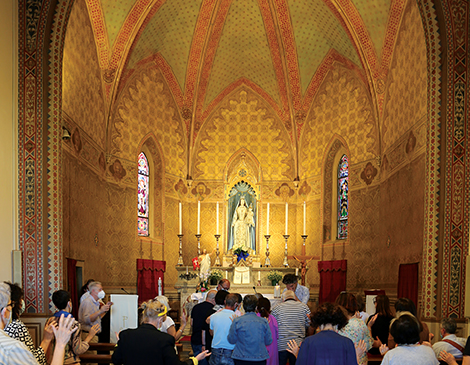
Three weeks after I decide to end my pilgrimage in Gubbio, my mother and I drive to Lily Dale, New York, on the eve of her 63rd birthday. It’s Mom’s own pilgrimage, a more fitting tribute than my hastily planned adventure.
“Thirty years she’d been going here,” Mom says as we drive through Erie, Pennsylvania. “It took my mother to pass to go to a place she loved.”
Lily Dale is the largest congregation of Spiritualists in the world — I call it the White Light District — and it shows, even in its June off-season. Its walkable corridors, lined with angel statues and butterfly chimes, are quiet, yet dotted with pink-haired SUNY students and signs reading “MEDIUM BACK IN 30.” “Italy was one pillar of her life,” Mom
philosophizes, “this is the other.”
After a reading at the Healing Temple, we walk Lily Dale’s grounds, uncertain of the true meaning of our pilgrimages. We head south to the outdoor pews of Inspiration Stump, a faux tree podium nestled in the Leolyn Woods, where Nan allegedly saw a floating orb — her beloved Ralph, perhaps. “Mom!” she calls to the air above the Stump. “Mom, if you’re there, give us a sign. We’re here! Let us know if you’re with us!” My mother had spotted Canova’s Three Graces at a gift shop but still seemed relatively unfulfilled. Trees gently woosh for a minute or two. Leaving, Mom spots a sign for Lily Dale's Pet Cemetery. She laughs. “Tch, you know she never liked going there.”
Place becomes a person. It shapes them so exquisitely, that stepping into their realm is like entering their spirit. This imitation isn’t just the highest posthumous honor but possibly the best bridge to our future selves. “She would be thrilled to see us here,” Mom says. Her voice cracks. “Just thrilled.”
St. Francis died singing. When criticized for being loud and kooky, Francis guffawed. “Leave me be, brother,” he said. “For in spite of all that I endure, I feel so close to God that I cannot help singing.”
“Oh my God, look,” I say to Mom, stopping on South Street.
I can’t believe it. Popping out of a patch of residential shrubs, walled in by concrete brick: a foot-tall statue with a dove huddled on his right sandal.
“Look,” I say again.
“What,” Mom says from behind me. She finally turns.
“Who is that?” she says, as I kneel down to get a closer look.
Want an engaging longform piece like this one in your email inbox each week? Sign up for our free weekly “In the CLE” newsletter. It's your guide to fun throughout The Land. Arriving in your inbox every Wednesday, this weekend to-do list fills you in on everything from concerts to museum exhibits as well as giving you a great Sunday Read. Subscribe here.

